Please choose your country or region so we can show you the most relevant content.
It looks like you are in United States? Accept
Africa
- Algeria
- Angola
- Benin
- Botswana
- Burkina Faso
- Burundi
- Cabo Verde
- Cameroon
- Central African Republic
- Chad
- Comoros
- Congo
- Côte d'Ivoire
- Djibouti
- DR Congo
- Equatorial Guinea
- Eritrea
- Eswatini
- Ethiopia
- Gabon
- Gambia
- Ghana
- Guinea
- Guinea-Bissau
- Kenya
- Lesotho
- Liberia
Asia
Australasia
Europe
- Albania
- Andorra
- Austria
- Belarus
- Belgium
- Bosnia and Herzegovina
- Bulgaria
- Croatia
- Czechia
- Denmark
- Estonia
- Finland
- France
- Germany
- Greece
- Greenland
- Holy See
- Hungary
- Iceland
- Ireland
- Italy
- Latvia
- Liechtenstein
- Lithuania
North America
Middle East
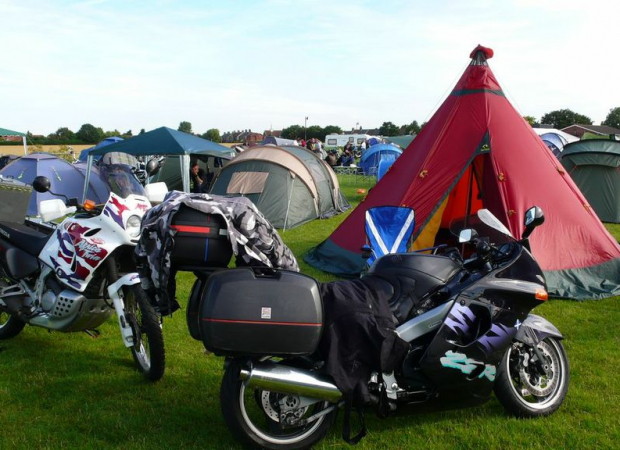
Adventure Camping
Zen and the art of motorcycle camping
14 Oct 2013
We present here the perpectives of Sheila Kiggins, our guest blogger for this piece. Sheila owns a motor bike and a Tentipi Zirkon 7 Light – both of which are loved and put to maximum use each year, touring throughout Britain and its Atlantic influenced climate. We learn something here of the history of motorcycle touring; the experiences gained; and also some hugely beneficial tips on equipment too.
These stories, we find inspirational. They seem to reflect an innate human need to simply “go”. Nowadays we’re not following migrating food sources, or responding to resource pressures. We have the choice to simply “go”. – whether by foot, canoe, 4 x 4, boat, or motor bike. Here, we learn something of the joys (and tears) of this kind of travel.
— 0 —
“Motorcycling is a tool with which you can accomplish something meaningful in your life. It is an art.” Teresa Wallach
There are only really two kinds of motorcyclist. One kind, whose first question will always be “how fast can I make it go?” And the other, who will look at two wheels and wonder not how fast, but how far.
The godfather of motorcycle adventure is Ted Simon. In 1973 Ted gave up his job as a journalist and set off round the world on a 500cc Triumph Tiger.
In four years he travelled 64,000 miles through 45 countries. Jupiter’s Travels, the story of his journey, is the original and best motorcycle travel book. It inspires new travellers every generation, including Ewan MacGregor and Charley Boorman.
Ted Simon genuinely believed himself to be a pioneer. “When I rode out from London to go around the world in 1973 I was fully prepared, somewhere along the way, to lose my life. Nobody to my knowledge had made such a journey before (it turns out I was wrong about that. A few people had) and I thought it would be as dangerous as it was exciting.”
I hope Ted wasn’t too disappointed when he found out that he was in fact beaten to the title of “First motorcyclists across the Sahara” by a pair of indomitable British ladies in a motorcycle and sidecar.
Theresa Wallach and Florence Blenkiron were part of a thriving group of women racers and riders in 1930s England. A lighthearted suggestion that Florence should ride to South Africa to catch up with friends and family developed into a serious plan to be the first to make a north-south transit of Africa by motorcycle. With a 600cc Panther, a Watsonian sidecar and trailer, a tent by John Edgington and some help from the French Foreign Legion, Florence and Theresa successfully covered 14,000 miles in seven months and arrived in Cape Town on 29th July 1935, to be met by The Earl of Clarendon, for those were different times.
“Why did you do it?” Florence wondered, in her book, The Rugged Road. “Despite the hardship, we had the time of our lives and learned much when wandering around in contact with thought provoking people in interesting places. There were occasions for despair, but with our self reliance and clear objective we never lost enthusiasm. It was not an easy task, but we gained more worldly wisdom out of it than ever expected.”
Ted Simon says something very similar. “The goal was comprehension,” Ted writes, “and the only way to comprehend the world was by making myself vulnerable to it so that it could change me.”
I would, perhaps, be a rather better motorcyclist if the first two books I had bought were riding manuals rather than Jupiter’s Travels and Zen and the Art of Motorcycle Maintenance, an exploration of the meaning of life disguised as an account of a motorcycle journey across North America
But these books taught me why to ride, which I think is far more important than getting to grips with countersteering, observation, and how to do a U turn without putting your feet down – though my insurance company may disagree – and gave me the itch to head for the horizon.
To ride is to discover. While there may be no new routes to conquer, and sadly, political change has made many of the existing ones impassable, every traveller is discovering something new. Not just about the world, but about themselves.
Travelling by motorcycle is not like travelling by car or camper. You are not in your vehicle, you are on it. You are enjoying the world, not sealed away from it behind a windscreen. Sometimes you are enduring the world. Riding alone in high winds or bad weather tests even the most optimistic of travellers. Some days the best thing about travelling by motorcycle is stopping.
The benefits of being in such an intimate relationship to the road are immense. The world does not smell of Magic Tree or service station coffee. It does not sound like the babbling of drive-time DJs. Each mile has its own unique character, from Devon’s rich red earth to the salt-swept beaches of Shetland.
Most years I ride from Lands End to John O Groats with my motorcycle club. Some people do these 850 miles in a weekend. Some people do it in a day. One of the guys in my office is going to do them as a Triathlon – one third cycling, a swim down Lake Windermere, and the rest as a very long-distance run. In October. Those are proper feats of endurance. Doing it over 10 days – although we do, strictly speaking, reach John O’Groats on day 4 – never really feels to me like something worth asking others to put their hands in their pockets for.
So if it’s not a fundraising extravaganza, nor a test of personal stamina, what is the point of loading up a large motorcycle and spending a lot of money on petrol to ride in a great big circle and end up back where I started?
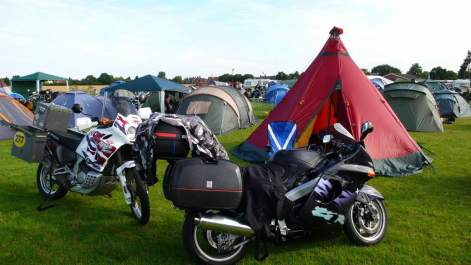
There is a simplicity in a day in which the only tasks are to take down a tent, ride for 300 miles in roughly the right direction and without hitting anything, find the next campsite, have a shower and put the tent back up.
The problem with simple days is that it leaves the rest of my brain with too much time on its hands. The strangest things get stirred up, and it’s a given that at some point on a long ride I’ll be in tears.
I live in the Fens. Roads round here go straight for about a mile, then do a 90 degree bend and carry on straight again. I have lost the knack of flowing through the kind of beautiful twisties that take you from Dingwall to Dunnet Head, and everyone passes me. Some with impatience. It turns out that being 40 years old and riding a motorcycle beside the sea feels a lot like being the fat kid with bad eyesight that no-one wanted on their team in P.E. Which I thought I’d got over a long time ago…
The advantage of a full-face helmet is that no-one can see you cry, but you can’t keep it on when you get to the cafe without looking a bit odd. The advantage of getting to the Laidhay Croft Museum Cafe is that there’s not much in the way of residual emotional trauma that can’t be cured by a cup of tea and a Tunnock’s caramel wafer.
So I ride long distances as a kind of rolling mediation, to shake loose all the accumulated rubbish which I don’t need to carry round in my head any longer. It’s sad to turn south again, because then each day takes me nearer the real world. But each year I go back to what passes for normal life with lessons learnt. Last year I learnt how to change my front brake pads. I learnt a lot about sheep shearing. I learnt how to swear in Arabic. I learnt that you can be hit by a car and walk away, though that’s not a lesson I plan on repeating any time soon. And I learnt that it’s better to ride within your limits than worry what other people think about you. I would not learn these things riding in a car.
Bikes and camping are a perfect match because they are both about freedom and self reliance. There is immense peace in knowing that in the small space available on a bike, all the essentials necessary for a comfortable night and a good breakfast are safely stowed, and that the difference between a weekend away and a trip round the world only really turns on whether or not work would miss you on Monday.
A good trip isn’t about the bike. Although there’s a fashion for huge gnarly off-road beasts at the moment, Nathan Millward rode home from Brisbane to Yorkshire on a 100cc ex-Australian Post bike called Dorothy. There’s a lot to be said for a bike you can fix with araldite and a toothbrush.
And the choice of camping gear is an equally personal one. Some of the old rockers I ride with speak with nostalgia of riding to the south coast with nothing but a tarpaulin to stretch out on the beach and sleep under, though I do wonder how rose-tinted those particular recollections truly are.
Some riders swear by tents so tiny that when they crawl in at night they look like caterpillars about to pupate. It keeps you warm, they say. I can only assume they sleep in their bike gear, because I find that mine, when taken off, takes up almost as much space as an extra body. Sometimes I wonder whether I should buy it its own sleeping bag. It lies neatly beside me, like a shed skin.
Three things dictate my choice of tent. It must pack down into a bag narrower than my handlebars. When I lie in it, my feet must not touch the sides. And I must be able to put it up by myself, for though I like to ride with others, I need to know that I don’t have to. In 1997, the year after I passed my motorcycle test, I bought an Aztec Galleria 3-man tent. It has two poles and pegs out with 8 pegs in less than 5 minutes. It has a porch on each side so in bad weather I can cook, and a loop in the door to hang a torch from so that I can read. It has taken me to Wales, from Lands End to John O’Groats three times, and to Shetland.
It has no real flaws save one. The older I get the more claustrophobic I become. I aspire to travelling with a companion and in that tent there simply wasn’t room. In 2009 my head was turned. The Camping and Caravan Club magazine reviewed the Tentipi Safir. A tent you could stand up in! More importantly for the British biker, a tent you could hang clothes up in to dry! And that came accessorised with reindeer hides to sit on. It called to me. I looked at the website, and I was done for, because the Tentipi Zirkon Light not only came in a colour which matched my hair, it was sold as the perfect tent for motorcycling.
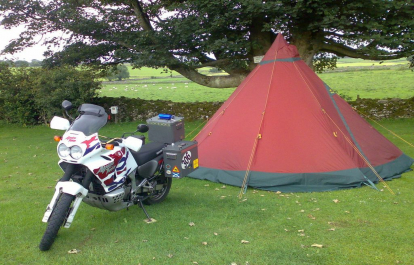
This may not sound like much. If you are a rambler, or a bicycle camper, or a car camper, you are a recognised market and camping firms queue up to offer you products that meet your needs. If you are a fell runner who likes to take part in the Original Mountain Marathon, there is a company out there aiming squarely at you. But, even though bikers are some of the most expert and accomplished campers you will ever meet, we’re rarely recognised as customers in our own right. So it was a joy to see bikers being shown as happy tipi users.
I bought a Zirkon 5 from Nordic Outdoor, panicked, sent it back and changed it for a Zirkon 7. Then I set off for Hayfield in Derbyshire for the annual summer gathering of my motorcycle club. We like to visit the well dressing which takes place there every July, though we are so mild-mannered that last year the locals mistook us for a coach party.
“Don’t start putting it up yet,” I was told. “Paul’s still in the shower and doesn’t want to miss the entertainment.”
Somewhere on the internet there is a set of sarcastically-subtitled photographs, showing a row of bikers on deckchairs calmly eating ice cream and watching me as I lay out my measuring cord, knock in the eight big pegs, make another circuit hooking the rings over the pegs, lift the pole, adjust the floor, and sit down for a well deserved cup of tea, before realising that I had bought a tent only slightly smaller than St Paul’s Cathedral.
It is not a tent for the shrinking violet. People like to come and talk about it. But people like to come and talk about my bikes too, so I am used to that. It’s one of the things I like best about riding. I learnt to love the fact that you can probably see my tent from space when I started taking it to rallies. A motorcycle rally, of the non-competitive type, is a three day festival. Several hundred tents go up in the space of two hours on Friday night. A bright red tent nearly three metres tall is a lot easier to find in the small hours of Saturday morning than a small green dome. And it’s a lot less easy for people to fall on top of after too long in the beer tent.
We have had teething problems. It used to rain on me inside the tipi. I had not realised “Embrace the elements” was to be taken quite so literally. But it turned out to be a simple problem. It is, apparently, important to arrange one’s Velcro flaps pointing up, not down, to prevent the rain from creeping in. A flaw in my pegging technique leaves my tipi always looking like it is hovering slightly above the ground, in anticipation of the mother ship calling it home. And I am still not quite sure, in the absence of a porch, of the best way of keeping muddy boots out of the living space. At the moment I work on a “wet half/dry half” system. If there are better ways, I would love to know.
But, oh, the advantages! There is room for a double air bed between the pole and the walls, for I have finally acquired a travelling companion who also rides a bike. There is room for two folding chairs. There is room for all the boxes and jackets and helmets and stoves and boots that come off two touring motorcycles. And you can open the roof and look at the stars without getting out of bed.
My tipi and I have not yet ventured outside Britain. I realise that owning a nearly-top-of-the-range Nordic adventure tipi to go camping in Yorkshire is a little like pony trekking on Red Rum. But I own a tipi for the same reason I take photographs on a vintage Leica and ride a Triumph – using tools sets us apart from monkeys and I want my tools to be really, really good ones. But also because this is the last tent I shall ever buy. When Travelling Companion and I set off for the Sahara – which is, after all, just four days ride from London – the tipi will be coming with us.
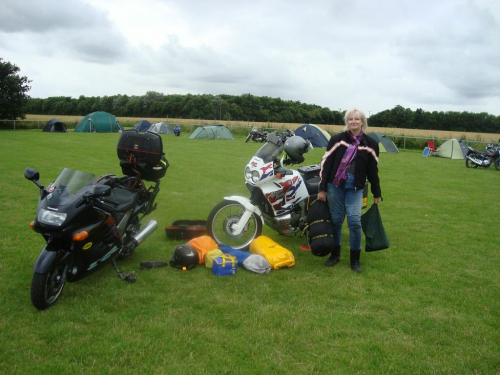
PACKING FOR THE ADVENTURE
- Almost any bike will cope with a tent and some luggage. I’ve ridden to Shetland for a week’s camping with a couple two-up on an exotic Italian superbike, though stops were dictated not by tank range but by how uncomfortable the pillion had become on her tiny perch.
- Size is more important than weight. Car camping gear tends to be big and heavy; kit for backpackers is tiny, lightweight and expensive. The bike is doing the heavy lifting but don’t go mad: a heavy bike is less fun to ride. I parked in a sandy car park with too much kit on the Triumph once and had to get pulled out by the coastguard after the weight made the bike sink to its axles.
- After your tent, your sleeping bag is likely to be the next most bulky item. Down bags pack small but suffer from the damp – consider a dry bag like Ortleib or Exped if you choose feathers.
A good sleep mat completes your comfort holy trinity. Personal preference counts here – some people like air beds, some people prefer the insulation of a Thermarest. Some people like army surplus
- camp beds – the legs often fit neatly across a seat as part of a bundle made up of tent, sleeping mat, chair and bed. I like the Exped DownMat because it’s warm and I don’t slide off it.
- Every piece of kit needs to earn its place, whether you’re filling a tank bag or a set of Metal Mule panniers. But make room for things that make you happy. I need a book to read, a journal to write in, and the makings of a good cup of coffee in the mornings. These are not luxuries. Other essentials insisted upon by bikers I ride with include a folding chair, a proper towel, Crocs for the shower, and a good bottle of red.
- The same goes for clothes. Take half what you think you need – it will always be possible to wash them on the way. But if you have one piece of clothing that is super-warm, or incredibly comfortable, or makes you feel like a human being after 400 miles on the road, make room for it. I have a vintage pleated dress that looks great on the beach or in the pub, and folds down to nothing.
- When it comes to packing, the first rule is, be organised. If everything has a place and is always stowed in it, you’ll laugh in the face of making camp after dark in the howling rain.
- The second rule is, plastic bags are your friends. You don’t have the luxury of a car boot to keep things dry in while you get the tent up. Keep things in dry bags or even supermarket carrier bags and you’ll always have at least one pair of dry socks to put on. And if your feet are dry, you can cope with anything.
- The third rule is, at least two straps. This may just be me being paranoid, but I’d rather spend twice as long strapping my bags on the bike than have to chase my escaping underpants down the road.
The fourth, and final rule is to carry with you at all times the old adage “The Journey is more important than the destination”. This, and the ability to laugh at one’s self could be the most important items to take along on your next motor cycle adventure.
Bon voyage……..
— o —
Related blog posts
It was the first day of the trip, adventurer Mike Fuchs and his friend Eric Folz had just a couple of hours before been dropped off as far north as they could possibly come in Svalbard when they saw them. Two polar bears, one mother and its cub. A situation that could become deadly if the bears decided to have a closer look on their new visitors.
“I know how protective the mothers can be of their cubs. We had to set up our camp in a place that provided a good overview of the location so we could spend the night bear watching. It was both a scary feeling seeing them so early into our trip, but it was also very fascinating”, says Mike Fuchs.
Wouldn't it be exciting to spend the night right in the middle of a zoo? – That is exactly what you can do at Skånes Djurpark, a wildlife park in southern Sweden. At their campsite, Camp Oak, you stay in the park after it closes and will make yourself at home in a Nordic tipi from Tentipi. When the night comes you might just fall asleep to the wolves’ howls.
Skånes Djurpark is a Wildlife Park with a long history, it dates back to 1952. It focuses on animals from the Nordic area and has always lived by the ruling with “no animals in cages”. The animals live in large paddocks that recreates the animals’ natural environments.
Lennart Pittja is a Sámi entrepreneur with a mission: with his world-renowned eco-tourism company he wants to spread the knowledge about his people – the Sami, indigenous of northern Scandinavia and Russia. With over 20 years of experience as a wildlife guide and nature photographer in the arctic region he started Sápmi Nature Camp. Where his guests stay in Nordic tipis from Tentipi on his reindeer herding land outside of Gällivare, in northern Sweden.
At Sapmi Nature camp you can experience real winter, see the northern lights, eat traditional Sami food, and have a cultural exchange in a genuine atmosphere. The scenic location has gained attraction from around the world. In 2017 it was listed by National Geographic as one of the top 21 places in the world to visit if you care about the planet.
Prepare before setting out for winter camping. Here are nine tips and tricks from Tentipi about what you need to think of before you go: the right tent for winter camping, how to pack the snow, comfort in snow, which tent pegs to use, where to pitch the tent, about snow weight, what heat sources can be combined with the tent, how to make a fire safely and other equipment.
Choose tents according to occasion, different tent types work differently at winter camping. When it’s icy, the tent needs to be more robust than a tent which is exclusively used in summer. The tent frame needs to withstand a certain amount of snow and functional ventilation is important. If you want to use a heat source, for example a fireplace or a stove, the tent needs to have ventilation openings both at ground level and at the top. Without a heat source, a smaller tent is preferable, as it heats up faster when the air volume is smaller.
A tent from Tentipi is a Nordic tipi and the tent has eight or nine sides, if it is not the smallest that has six sides. In the smallest tent you can stand straight if you are less than 160 centimetres long and in the largest you can get together several thousand people. The tent is versatile in more ways. Continue to read to see why these tents are so flexible and adaptable. This blog post is about the smaller tents in Tentipi's range, tents used by adventurers, families, hikers and others who want to live close to nature for a shorter or longer period of time.
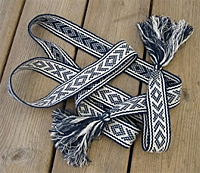
Sami cultural band
The Sami are a nomadic, indigenous people in northern Scandinavia. They are known as the people of the sun and the wind. Some Sami still work as reindeer-keepers. Traditional Sami clothes are decorated with colourful, woven bands and bands like this used as shoelaces.
Use fire safely!
Use fire safely!
Tentipi® Nordic tipis are designed to be used with an open fire or stove; it is this feature that makes them a home from home in all weather conditions. But please check local regulations, read and understand the instructions provided, and make sure you are fully competent to deal with the risks involved, before striking that match.
Tentipi® is a registered trademark of Tentipi AB












